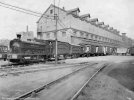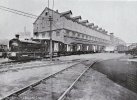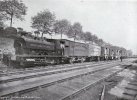RDowse
New Member
Hi All,
I'm hoping to tap into the forum's vast knowledge of wagon/van liveries. I came across this image of a train being prepared at the Mitchells & Butlers Cape Hill Brewery and noted the two M&B liveried vans behind locomotive Boniface. I'd not seen any with this livery before.

However, I then found this photo which is identical apart from the M&B livery is missing and the vans look just like the others making up the train. So was the image above "photoshopped" for publicity?

But on the same page of the booklet that features the image above of the vans without the M&B livery we have the image below. The liveries are back, but again looked to be "photoshopped". Note that the locomotive is now John Barleycorn, so although these photos appear in the same publication, I'm not sure if this was the same train or not. It looks to be a similarly staged photo but the location has obviously changed and the relative heights of the vans is different compared to the photos above.

So my questions to the forum are:
1) Did M&B ever have their own livery on wagons or vans?
2) Was it common practice to apply fictional brand liveries to wagons in photos? I find that very impressive considering I think these were done in the 1930s and that must have been quite an effort for a bit of marketing.
Thanks in advance.
I'm hoping to tap into the forum's vast knowledge of wagon/van liveries. I came across this image of a train being prepared at the Mitchells & Butlers Cape Hill Brewery and noted the two M&B liveried vans behind locomotive Boniface. I'd not seen any with this livery before.

However, I then found this photo which is identical apart from the M&B livery is missing and the vans look just like the others making up the train. So was the image above "photoshopped" for publicity?

But on the same page of the booklet that features the image above of the vans without the M&B livery we have the image below. The liveries are back, but again looked to be "photoshopped". Note that the locomotive is now John Barleycorn, so although these photos appear in the same publication, I'm not sure if this was the same train or not. It looks to be a similarly staged photo but the location has obviously changed and the relative heights of the vans is different compared to the photos above.

So my questions to the forum are:
1) Did M&B ever have their own livery on wagons or vans?
2) Was it common practice to apply fictional brand liveries to wagons in photos? I find that very impressive considering I think these were done in the 1930s and that must have been quite an effort for a bit of marketing.
Thanks in advance.
